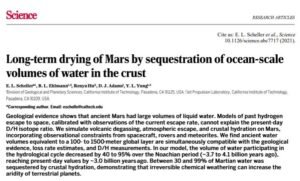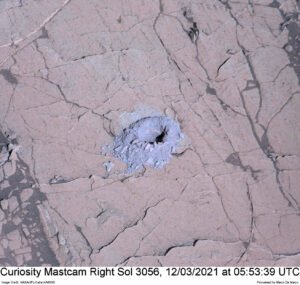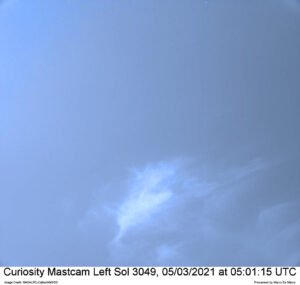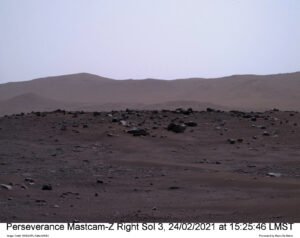Latest Posts
Mars’ water would not have dispersed into space, but would have been almost totally trapped in the crust!
According to a recent study just presented at the 52nd Lunar and Planetary Science Conference (LPSC), Mars would have retained between 30% and 99% of the water it originally possessed trapped in the crust.Also according to this study, the Red Planet initially had enough water to cover the entire globe with a deep layer between 300 and 1500 meters, equivalent to a volume of water similar to our Atlantic Ocean!Personally I have never believed the version of the MAVEN team that most of the Martian water is dispersed into space as the atmospheric pressure decreases and this study seems to confirm what I have assumed for years.I fear that this study could raise quite a fuss if taken into proper consideration; we’ll see!Jet Propulsion Laboratory article:“New Study Challenges Long-Held Theory of Fate of Mars’ Water.” https://www.jpl.nasa.gov/news/new-study-challenges-long-held-theory-of-fate-of-mars-water Article Science:“Long-term drying of Mars by sequestration of ocean-scale volumes of water in the crust” https://science.sciencemag.org/content/early/2021/03/15/science.abc7717 Article Science (PDF):“Long-term drying of Mars by sequestration of ocean-scale volumes of water in the crust”. https://science.sciencemag.org/content/sci/early/2021/03/15/science.abc7717.full.pdf This post has been automatically translated. See the original post here.
Curiosity Sol 3057, March 13, 2021
At 03:35:27 UTC the Mastcam Right captured a rock with an unusual appearance.It is certainly a sedimentary rock, but furrowed by a myriad of limestone veins, sometimes branched, that seem to converge towards the right side of the rock itself.Note also the amount of detail present; truly spectacular!The original image is a black and white encoding of the Bayer mask that has been converted to color through a process called “debayering” or “demosaicing”. In addition, the photo has undergone a reduction of noise due to Jpeg compression, white balance and a slight increase in microcontrast and color saturation in order to make the colors more similar to what the human eye would see. Original image: https://mars.nasa.gov/msl-raw-images/msss/03057/mcam/3057MR0159680080405702C00_DXXX.jpg This post has been automatically translated. See the original post here.
Curiosity Sol 3057, March 13, 2021
At 03:42:35 UTC the Mastcam Right resumed the excavation of “Nontron”.You can already clearly see the first changes, as well as the onset of greenish spots in the upper part of the image (see https://www.facebook.com/PianetaMarte.MdM/posts/3750913184991847). We will see in the coming days…The original image is a black and white encoding of the Bayer mask that has been converted to color through a process called “debayering” or “demosaicing”. In addition, the photo has undergone noise reduction due to Jpeg compression, white balance and a slight increase in microcontrast and color saturation in order to make the colors more similar to what the human eye would see. Original image: https://mars.nasa.gov/msl-raw-images/msss/03057/mcam/3057MR0159700080405724C00_DXXX.jpg This post has been automatically translated. See the original post here.
Curiosity Sol 3056, March 12, 2021
At 05:53:39 UTC the Mastcam Right has filmed the new excavation in the rock made by Curiosity’s driller.This drilling, called “Nontron”, is 1.6 cm wide and shows us the true color of the rock apart from the reddish layer that covers it.The excavated material appears turquoise mixed with areas more prone to pink. It will be very interesting to observe its evolution in color and shape over time.The original image has undergone noise reduction due to Jpeg compression, white balance and a slight increase in microcontrast and chromatic saturation in order to make the colors more similar to what the human eye would see. Original image: https://mars.nasa.gov/msl-raw-images/msss/03056/mcam/3056MR0159620010405692E01_DXXX.jpg This post has been automatically translated. See the original post here.
Curiosity Sol 3049, March 5, 2021
At 05:01:15 UTC the Mastcam Left has captured a beautiful white cloud standing out in a clear blue Martian sky!This is not the only cloud photographed, actually between Sol 2049 and Sol 3050 several clouds have been shot (see https://mars.nasa.gov/msl/multimedia/raw-images/? order=sol+desc%2Cinstrument_sort+asc%2Csample_type_sort+asc%2C+date_taken+desc&per_page=50&page=0&mission=msl&begin_sol=3049&end_sol=3050&af=MAST_LEFT%7CMAST_RIGHT%2C%2C), but I chose this photo because it seemed the most representative.It is evident that this is a cirrus made of water ice crystals; one only has to wonder how such a (officially) dry atmosphere can give rise to such dense clouds!In fact, if we consider that (officially) if we condense all the steam contained in the atmosphere we would get a layer of water of about one hundredth of a millimeter, the formation of such clouds should be impossible!Yet the clouds are there to see, nice and thick and plump!The original image is a black and white encoding of the Bayer mask that has been converted to color through a process called “debayering” or “demosaicing”. In addition, the photo has undergone noise reduction due to Jpeg compression, white balance and a slight increase in microcontrast and color saturation in order to make the colors more similar to what the human eye would see. Original image: https://mars.nasa.gov/msl-raw-images/msss/03049/mcam/3049ML0159290120407960C00_DXXX.jpg This post has been automatically translated. See the original post here.
Perseverance lands on Mars: reflections and comments on the search for life on the Red Planet
A double direct between the Observatory N. Copernico of Saludecio (RN) https://www.facebook.com/groups/infocopernico ) and “Planet Mars” by Marco De Marco https://www.facebook.com/PianetaMarte.MdM/videos/1325373517832429 ), carried out on February 18, 2021.Sabrina Rossi, Gian Franco Lollino and Marco De Marco were present. This post has been automatically translated. See the original post here.
Perseverance Sol 3, February 24, 2021
At 15:25:46 LMST the Mastcam-Z Right took a view of the south side of the landing site.The hills in the distance show us a slight blurring of the air, probably due to dust in suspension as the sky also shows reddish clouds on a blue background.All in all I would say that the environment seems very similar to that of the Gale crater, but let’s wait for the real research activity to begin…The original image has undergone noise reduction, white balance and a slight increase in microcontrast and color saturation in order to make the colors more similar to what the human eye would see. Original image: https://mars.nasa.gov/mars2020/multimedia/raw-images/ZRF_0003_0667217550_000FDR_N0010052AUT_04096_034085J01 This post has been automatically translated. See the original post here.
Incredible shot made by the Perseverance lander during the last phase of the landing; they are real images and not a simulation, yet the sky appears blue already at 10 km altitude at the opening of the parachute! Doesn’t this tell you anything?
https://www.youtube.com/watch?v=4czjS9h4Fpg This post has been automatically translated. See the original post here.
The first color image of Perseverance!
https://mars.nasa.gov/resources/25612/perseverances-first-full-color-look-at-mars/ This post has been automatically translated. See the original post here.
Post from February 18, 2021
Your browser does not support HTML video. Perseverance lands on Mars This post has been automatically translated. See the original post here.






